Pre-wedding photoshoot at Temple in Kyoto.
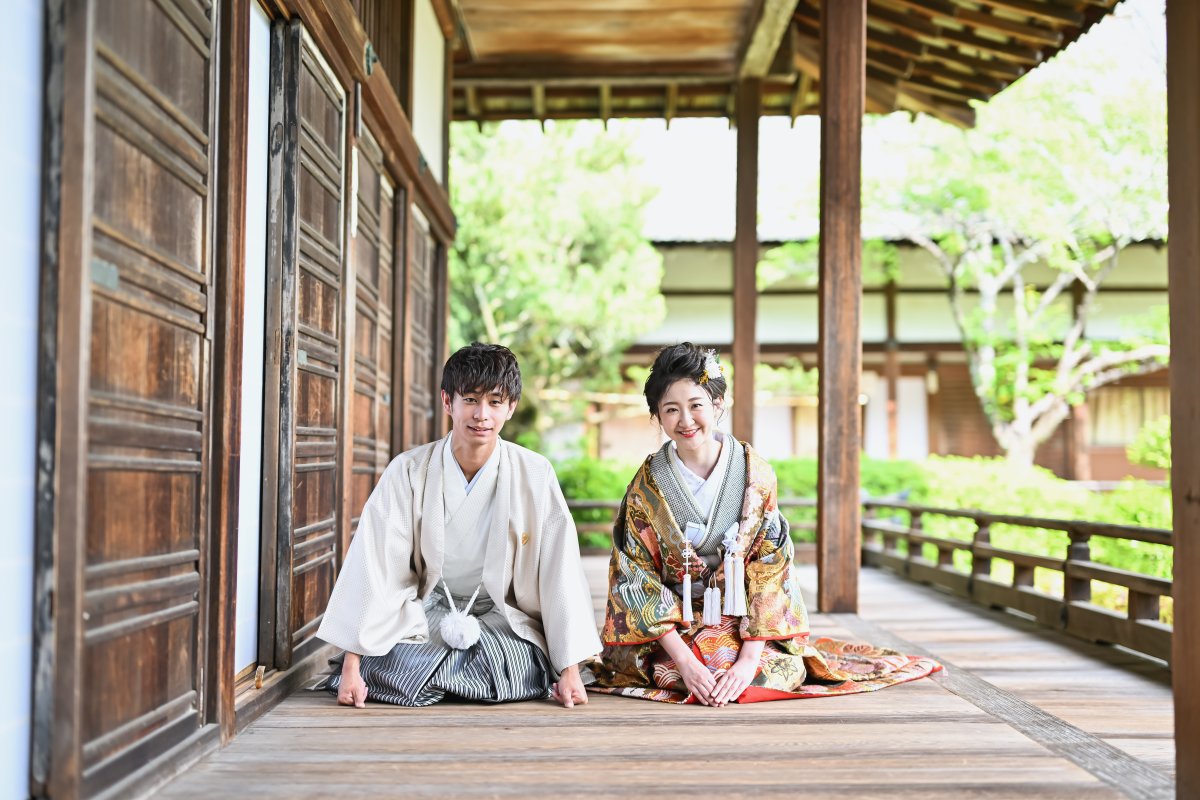
Hello there!
As the steamy days continue, are you feeling exhausted from the heat?
Now, while our studio is based in Nagoya, we also have a sister store in Osaka’s Shinsaibashi area, and we’re thrilled to offer photo sessions in Kyoto as well!
Today, let me introduce you to the immensely popular spot in Kyoto, Bishamon-do Temple.
Formally known as “Gohonzan Ango-in Izumo-ji Bishamon-do,” this temple enshrines Bishamonten, one of the Seven Lucky Gods, and is a head temple of the Tendai sect. Originally established in the third year of the Daihō era (807) near the present Izumo-ji bridge in Kyoto (now on the north side of the Imperial Palace), it was called “Izumo-ji Temple” but later became known as “Bishamon-do.” Despite overcoming conflicts and fires, the temple was rebuilt in its current location in Yamashina in the fifth year of Kanbun (1665). It houses historical buildings and cultural properties such as the main hall and the Tang-style gate, which preserve the architectural styles and atmosphere of the 17th and 18th centuries. The lush natural surroundings, known for cherry blossoms and autumn foliage, are also a sight to behold.
The “Fukiage Momiji,” or fallen maple leaves, make for a beautiful pre-wedding photoshoot spot, ensuring picture-perfect moments! With over 20 different shooting spots, there’s no shortage of places to capture stunning images!
From the cherry blossoms and wisteria in full bloom in spring to the vibrant greenery of summer, the colorful autumn leaves, and the magnificent snowy landscapes in winter, you can enjoy various photo sessions amidst the changing seasons!
Now, let me show you some actual photos from our photo sessions!
1.Vivid! The vermilion main hall.

Many of you may have seen photos of this vermilion main hall before, haven’t you?
The main hall enshrines Bishamonten, who is famous as one of the Seven Lucky Gods and the Four Heavenly Kings. He is highly revered for bringing prosperity in business and ensuring household safety, attracting devout followers from all walks of life.
While enjoying the picturesque natural scenery, you can capture vibrant and colorful photos. The contrast between the fresh greenery and the vermilion color is simply stunning!
2.The eastern covered corridor.

Bishamon-do Temple’s photoshoots are also famous for pictures taken on the covered corridors.
With corridors on the east, west, south, and separate buildings, there’s plenty of variety just on the covered corridors alone.
Here’s one shot taken on the eastern side.
3.The western covered corridor.
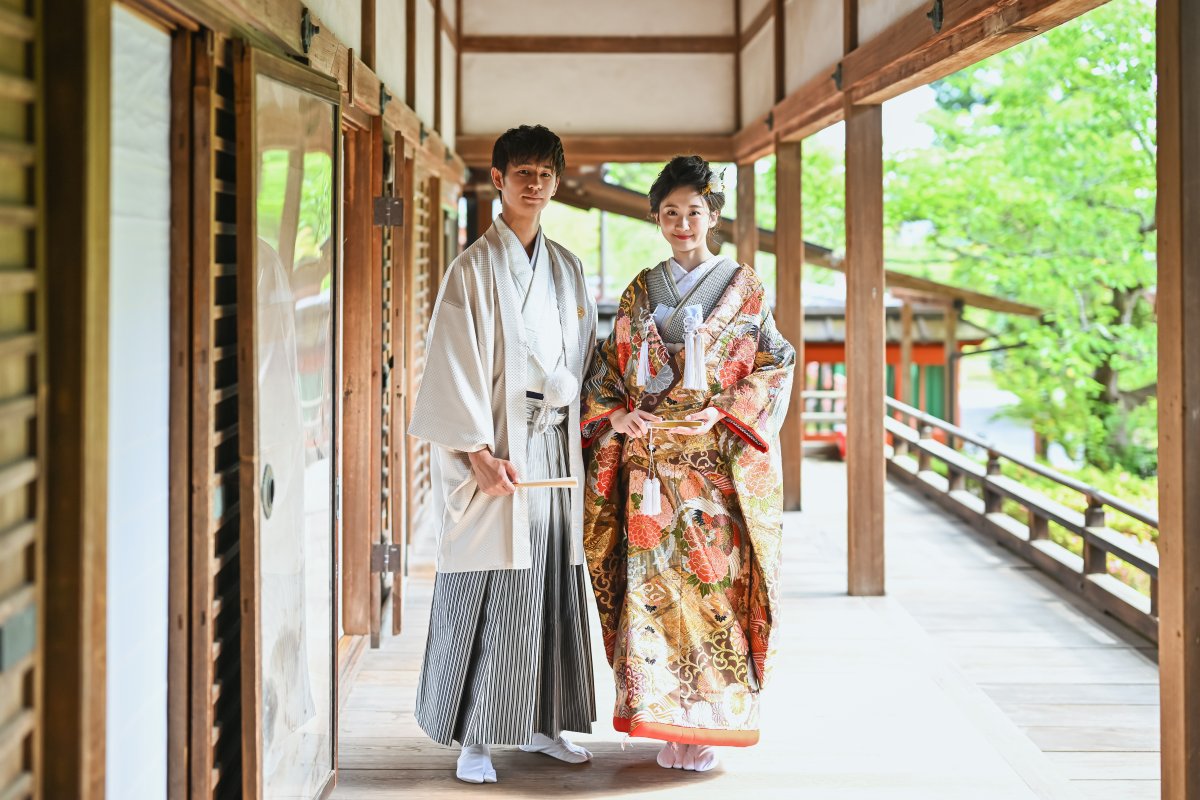
This is the western covered corridor.
The warm, wooden atmosphere exudes a calm and inviting vibe, perfect for pre-wedding photoshoots in traditional Japanese attire.
With a roof covering the corridor, you don’t have to worry about the weather, even if it’s not ideal!
4.The scenario of the vermilion plaster walls.
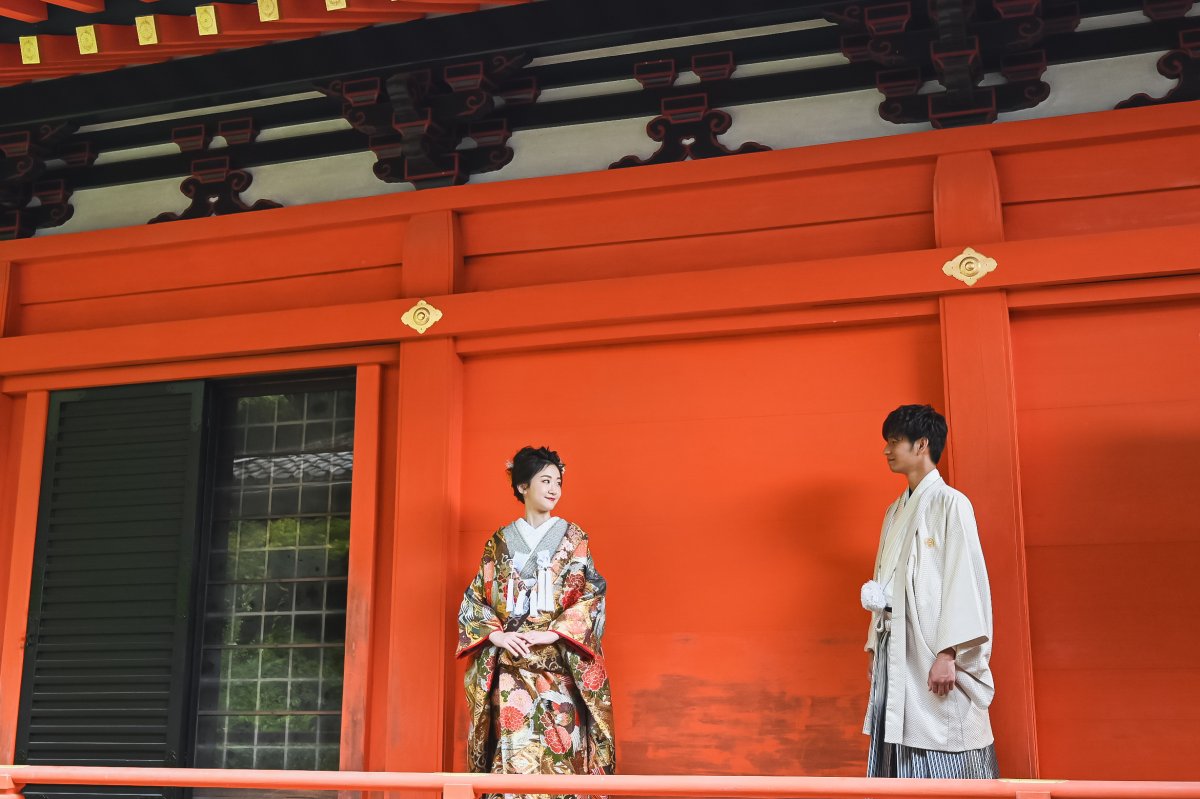
Photos taken against the backdrop of vermilion plaster walls exude a distinctly traditional Japanese ambiance.
Especially when photographed in white bridal attire, each color stands out beautifully.
The structures within the temple grounds date back to the reconstruction during the Edo period, employing techniques reminiscent of the Nikko Toshogu Shrine’s decoration.
It’s a delightful experience to capture photos while immersed in history.
5.Against the backdrop of the Shinden Hall.

The Shinden Hall is also designated as a cultural asset by the city of Kyoto.
The combination of historically rich architecture and beautiful natural surroundings is truly awe-inspiring!
It’s a spot where sparkling smiles can be seen.
6.The southern covered corridor.
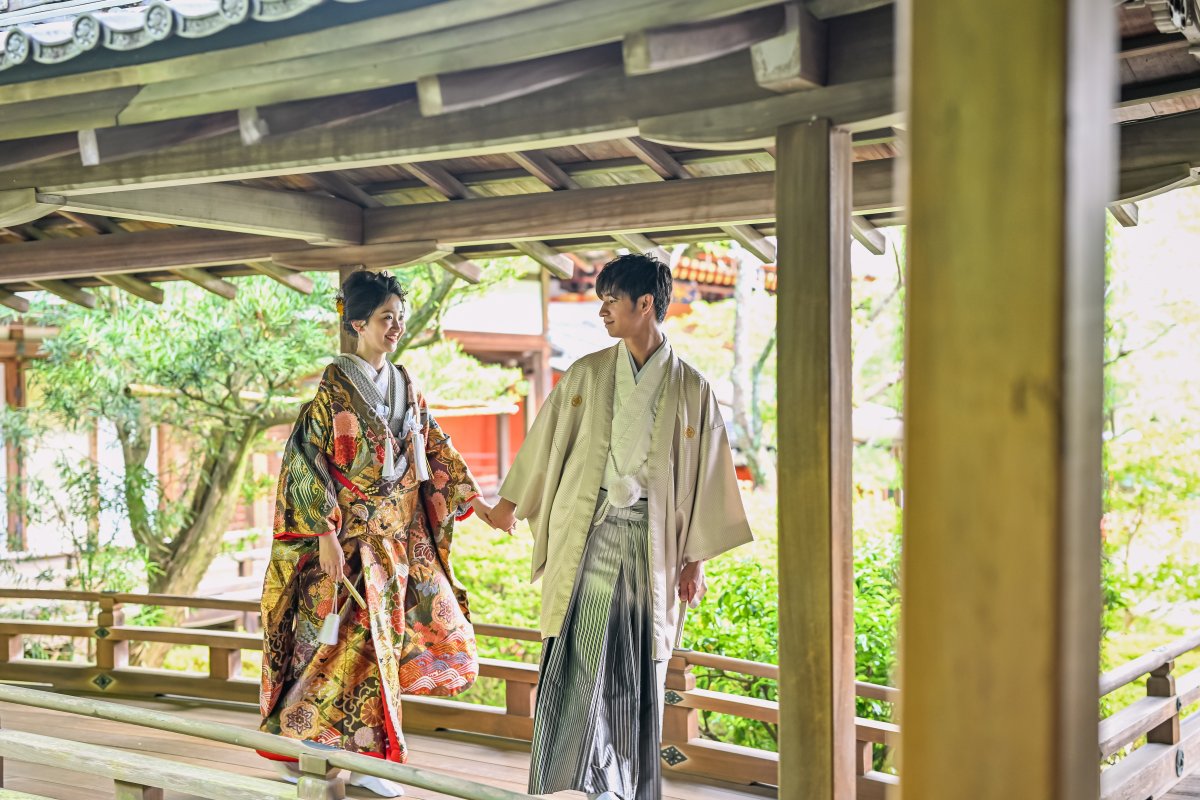
This is the covered corridor on the southern side.
Silhouette photos are also stunning here.
The greenery in the background turns a vibrant red during autumn, creating a breathtaking view.
7.The separate building's covered corridor.

In the covered corridor of the separate building, it’s possible to capture popular seiza (sitting on one’s heels) shots!
Amidst a solemn atmosphere and serene ambiance, you can preserve photos rich in Japanese tradition and atmosphere.
8.At the entrance of the Yamashikuro (Mountain Lacquer Pavilion).

A snapshot taken at the entrance of the Shinden Hall, where the famous calligraphy ‘Shōkan Ichigu’ is displayed.
‘Shōkan Ichigu’ conveys the meaning of ‘It is okay to be in a corner of society as long as you are needed,’ and ‘Become a powerful force behind the scenes.’
It is said to depict an ideal human figure according to Buddhist principles.
It’s a photo that truly captures the essence of Kyoto’s temples.
9.At the veranda of Bansui-en Garden.
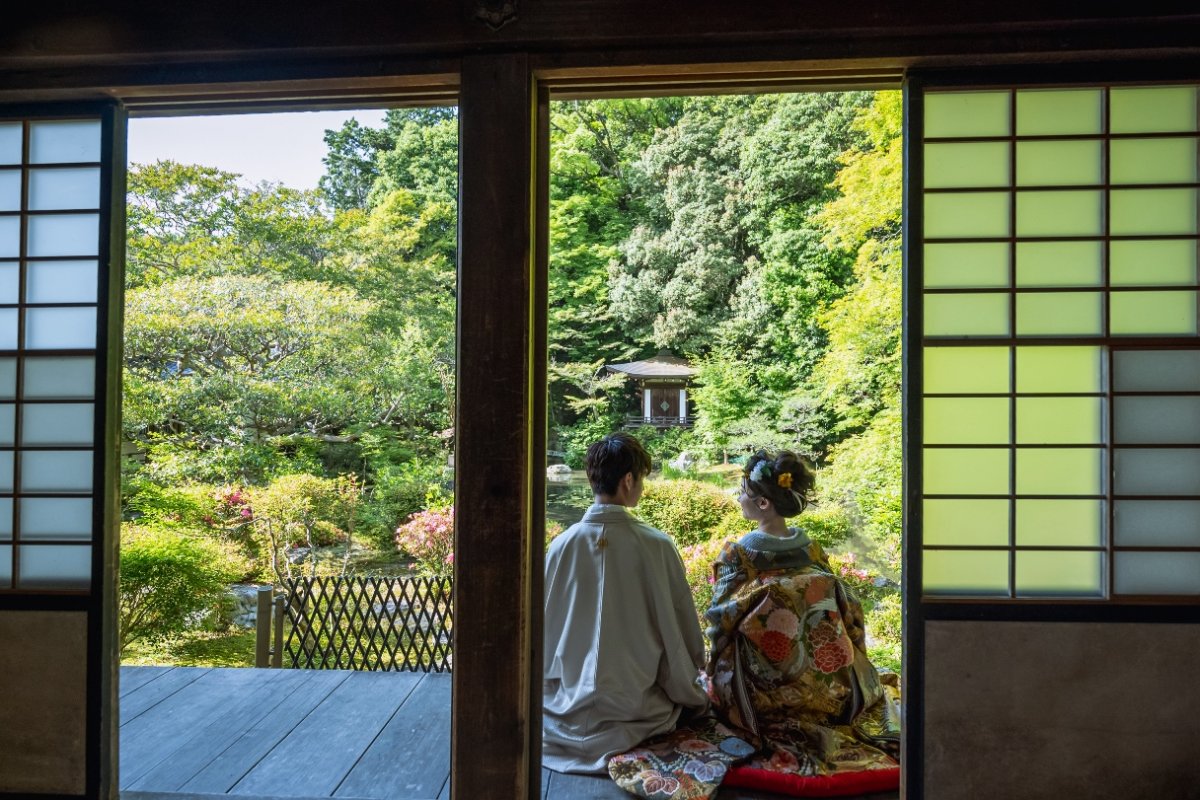
The sight of the two of you sitting on the veranda and gazing at the garden behind is truly heartwarming and makes for a lovely snapshot.
Bansui-en Garden is a pond strolling garden dating back to the early Edo period, located behind the Shinden Hall.
At its center lies a large pond, shaped like the character ‘kokoro’ (heart), with two islands.
To the north of the pond, beside the Kannon Hall, is a cascade of rocks where water from the valley of Anshojiyama flows, creating a serene atmosphere with its gentle sound.
On one of the islands stands a stone pagoda, serving as an accent alongside the Kannon Hall in the garden’s panoramic view.
The vegetation around the pond, which changes with the seasons, is also a highlight.
10.At the tea room.

A charming interior shot.
Unlike the open-air shots, this one exudes a tranquil atmosphere.
Moreover, all 116 sliding door paintings inside the Shinden Hall are the works of Kano Masanobu and are designated as cultural assets by the city of Kyoto.
These mysterious fusuma paintings, which change depending on the viewing angle, employ a rare technique called reverse perspective, where the viewer becomes the center of attention. Enjoy your photography session while marveling at these unique artworks.
11.The chozubachi (water basin) in Bansui-en Garden.
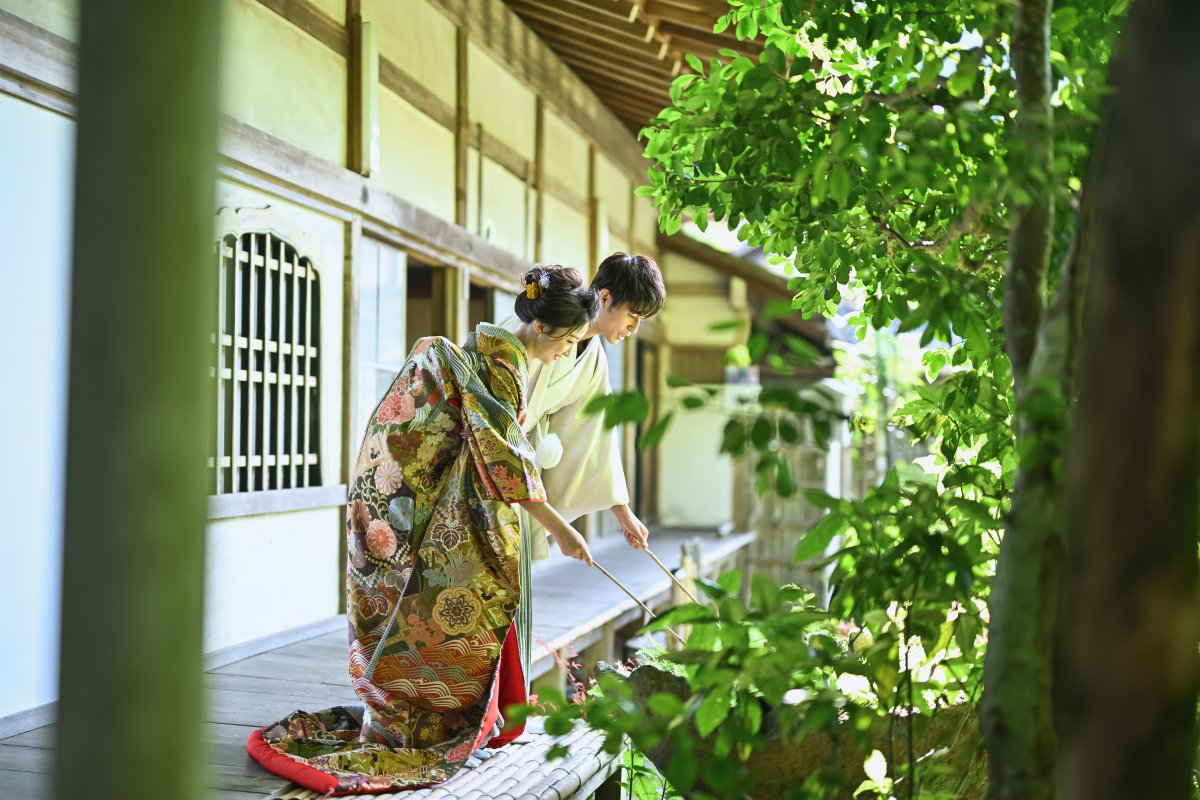
A temizuya, or water basin, is a stone basin used for purifying oneself before worshiping at Shinto shrines or Buddhist temples.
You’ve probably used one yourself when visiting these sacred places.
We’ll capture a natural shot of both of you holding the ladle.
12.Crossing the stone bridge.
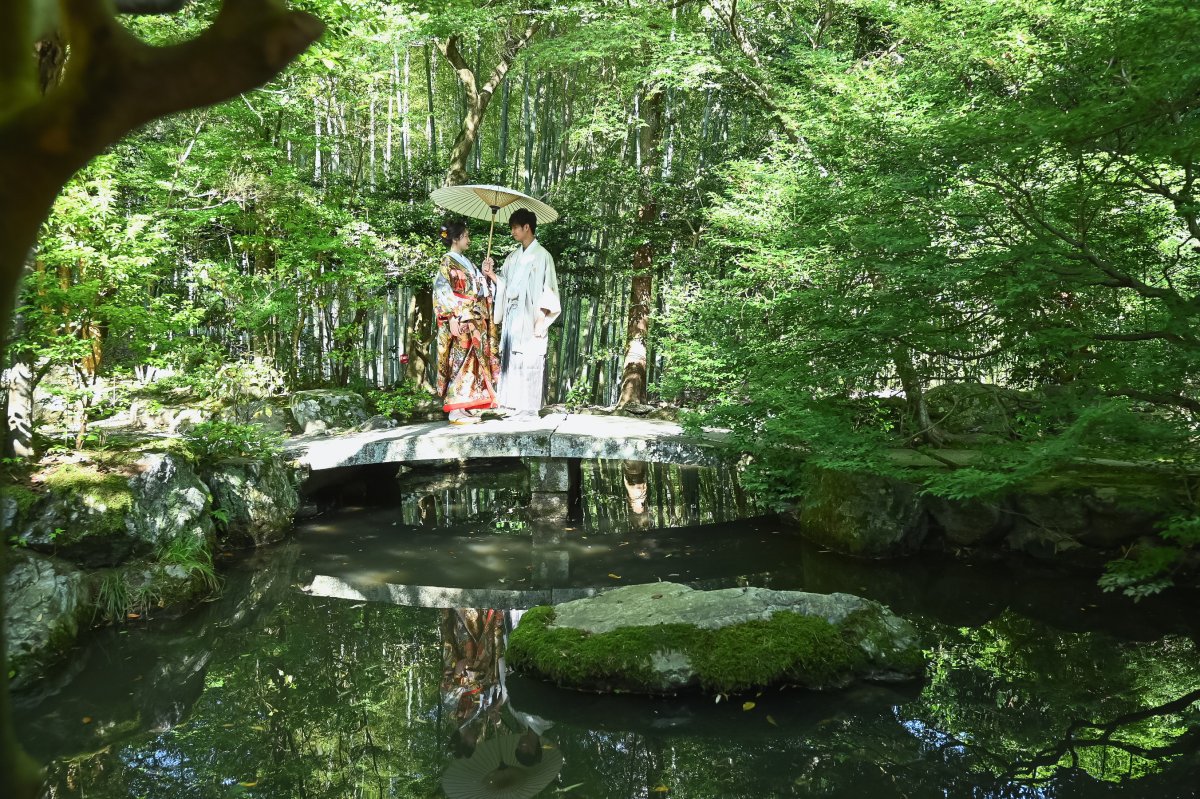
Like a painting come to life. The ever-changing scenery with each season is consistently beautiful and mystical, no matter where you look.
On calm, windless days, the reflection of both of you can be seen on the water’s surface, making for scenes you’d want to capture over and over again.
13.In front of Kōdai Benzaiten's altar.
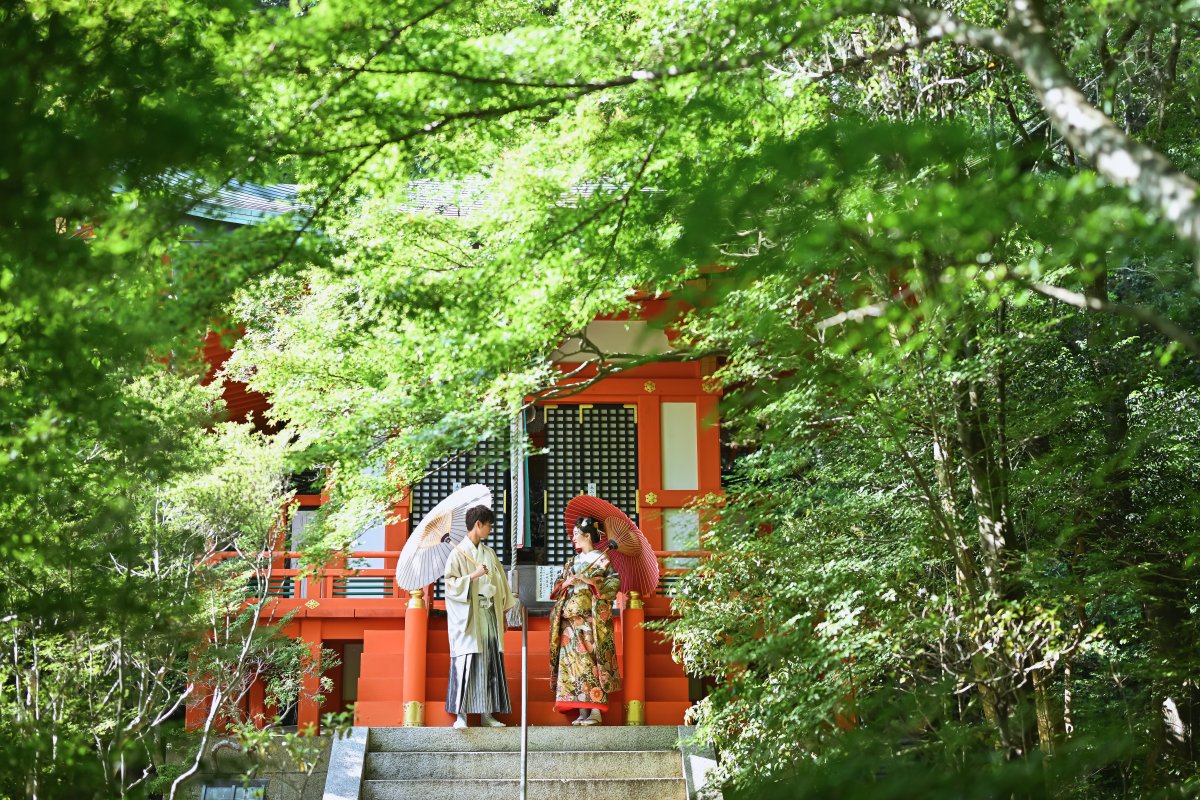
At the top of the hill beyond the torii gate stands Kōdai Benzaiten.
This hilltop Benzaiten was originally enshrined by Toyotomi Hideyoshi’s mother at Osaka Castle and later relocated to Yamashina for the well-being of commoners.
During autumn, the surrounding area is ablaze with vibrant red foliage.
For kimono photoshoots, traditional Japanese umbrellas are highly recommended!
They add an extra touch of elegance to the attire.
14.In front of the torii gate...

In front of the torii gate, peeking out from nature. A photo with the torii gate as the backdrop adds a mysterious touch to the shot.
Here’s a fun fact! The messenger of Bishamonten, called ‘Mukade’ in Japanese, is said to collect money with its hundred legs. Because of this, Bishamonten is worshipped as a deity of wealth and prosperity, believed to bring good fortune in business ventures.
15.The path leading to the main hall.
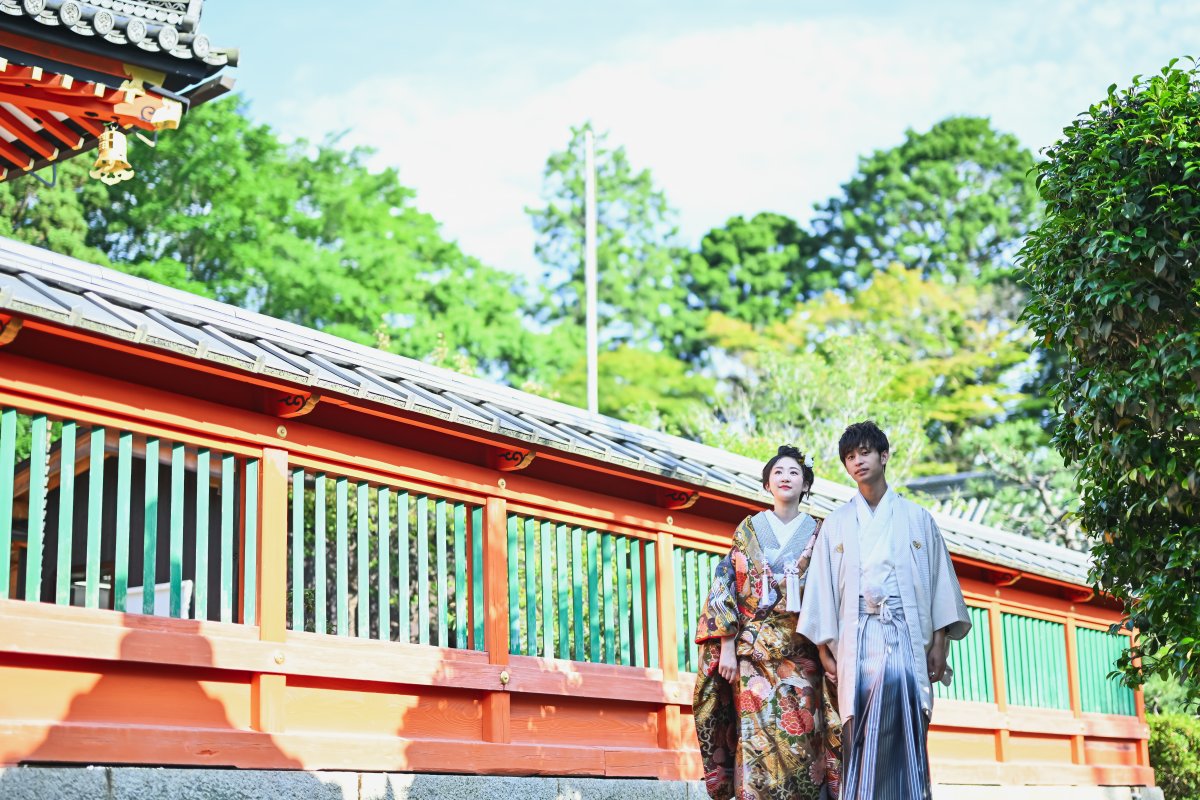
The side view of the Bishamon Hall from the path to the main hall is also beautiful. The contrast between the vermilion color and the green lattice fence is striking.
The Bishamon Hall presents different aspects depending on the season of visit. Apart from the popular autumn foliage, the vibrant greenery against the vermilion architecture ensures picture-perfect moments throughout the year!
16.The main gate and Niomon gate of the main hall.

At the top of the stone steps, you’ll see a large lantern with ‘Bishamonten’ written on it. Flanking the entrance are statues of A-Un, guardians of the gate. This vividly painted gate welcomes visitors for worship. A photo taken here captures a myriad of vibrant colors.
17.On the approach to the Bishamon Hall.
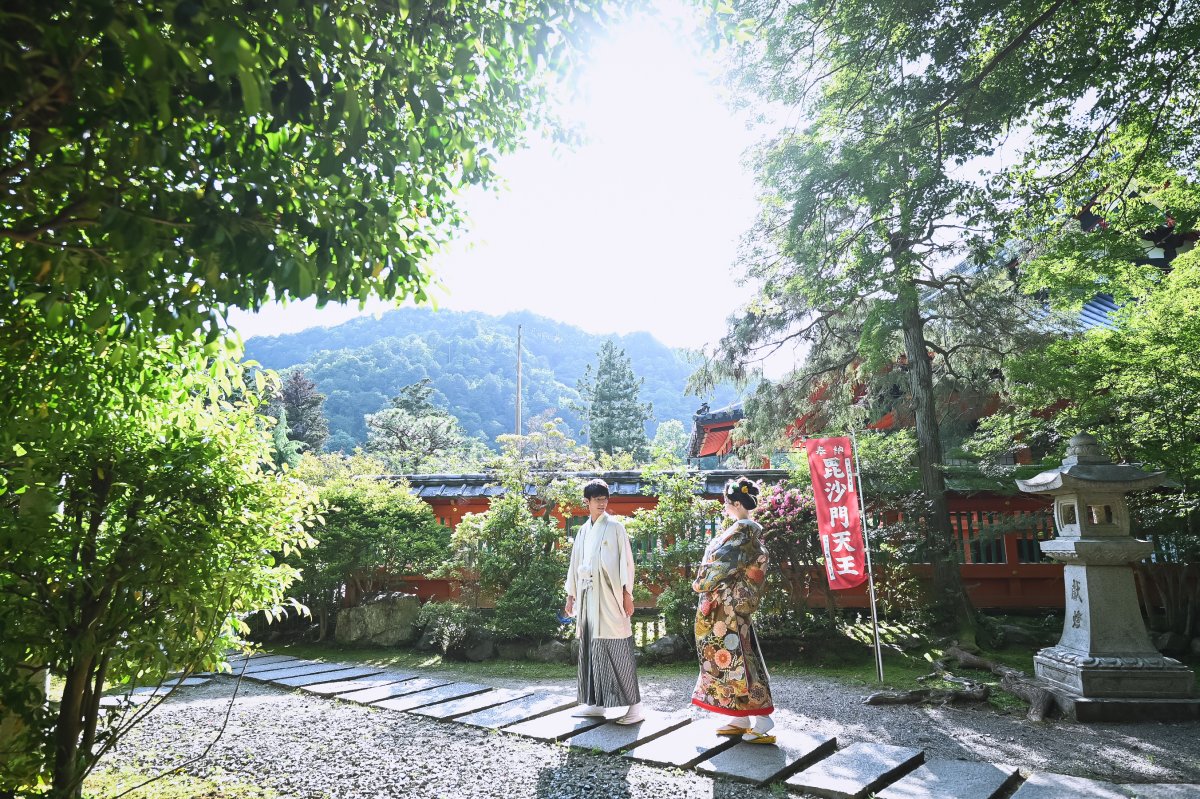
At the expansive grounds of the Bishamon Hall. A shot with the blue sky in the background is definitely a scene you’ll want to capture. With a wide variety of backgrounds available, it’s a recommended location for those who are undecided on where to shoot.
18.Alongside the weeping cherry blossoms

Bishamon-do is not only famous for its autumn foliage but also for its hidden cherry blossoms.
The splendid weeping cherry tree, which is over 150 years old, is renowned and reaches full bloom from early to mid-April. Known as ‘Bishamon Shidare,’ it continues to be beloved.
19.At the charming Chokushi-mon gate.
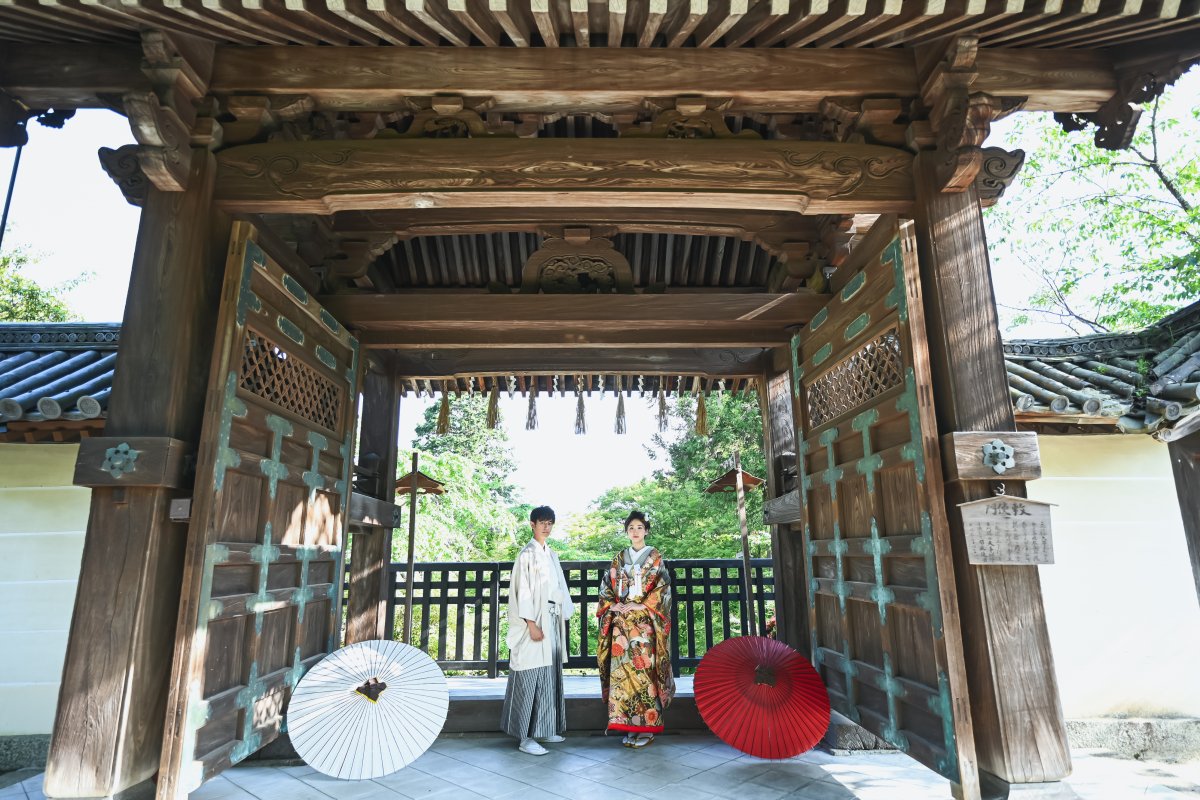
At the Chokushi-mon gate, graciously bestowed by Emperor Go-Nijo, serving as the main gate of the Bishamon-do temple. It remains closed to all but the chief priest’s ritual openings, adding to its air of mystique and warmth.
20.Chokushi-zaka, which has even been featured in commercials.
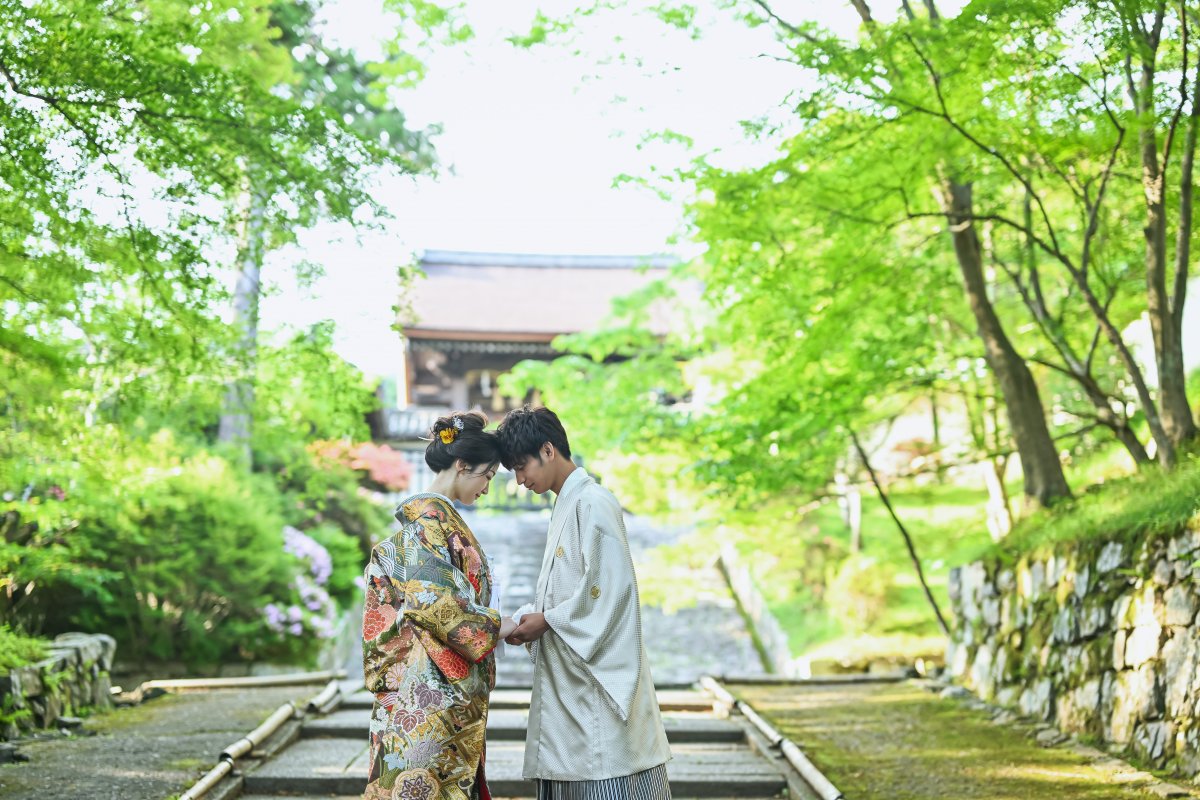
Chokushi-zaka is famous for its carpet of autumn leaves and has even been featured in JR Tokai’s “Let’s Go to Kyoto” commercials. Apart from the stunning autumn foliage, you can also enjoy the fresh greenery of spring, the lush green leaves of summer, the colorful foliage of fall, and occasionally, the snowy landscape in winter.
Why not capture the mystical beauty of nature’s changing seasons in this natural tunnel and take some enchanting photographs?
Last
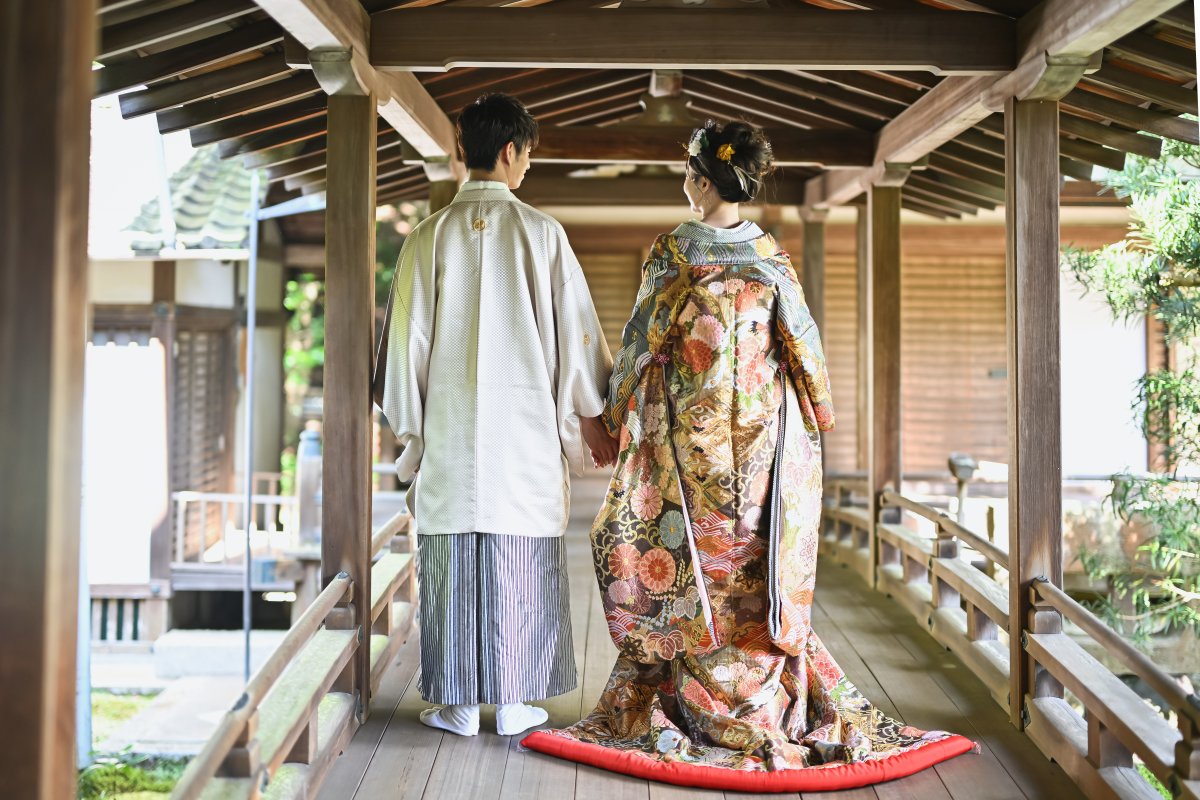
We introduced 20 stunning backgrounds for photo weddings and pre-wedding shoots at Bishamon-do. How did you find them?
If you’re looking for a place with a serene atmosphere, a genuine traditional Japanese wedding photoshoot in Kyoto, a location surrounded by nature, or simply a quiet spot to enjoy, Bishamon-do is the perfect choice for you.
If you’re interested, please feel free to contact us. We look forward to your reservation!
![WEDDING AVENUE [ ウェディングアベニュー ]](https://weddingphoto-japan.com/wp-content/uploads/2024/02/919e4a4f5992928ca463ed82a2f607b7.png)

![WEDDING AVENUE [ ウェディングアベニュー ]](https://weddingphoto-japan.com/wp-content/uploads/2023/11/542299bd51066ea8c78f712e60a3aed4.png)